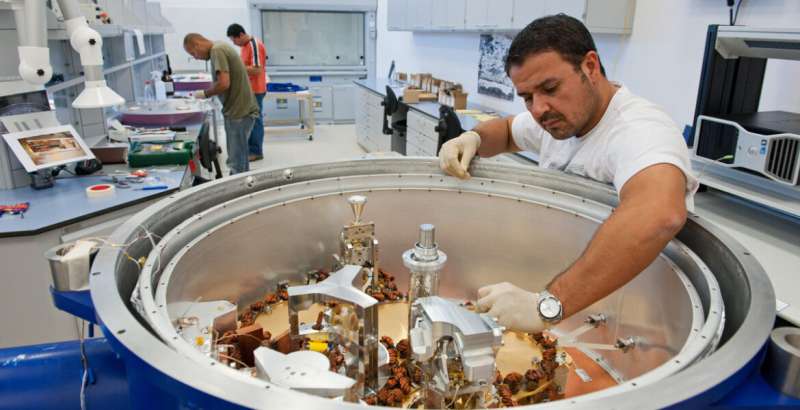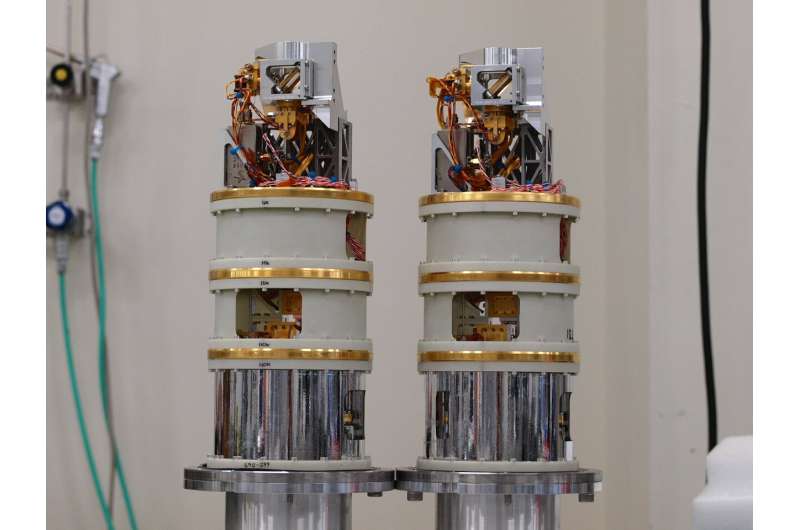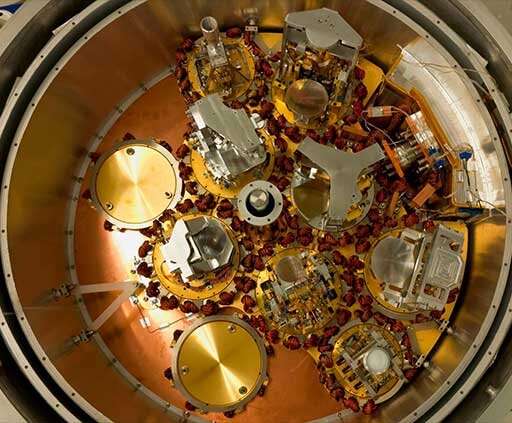Patricio Escarate, a cryogenics and vacuum technician at the Atacama Large Millimeter/submillimeter Array (ALMA) works on a front end, or chilled cooler that hold the cutting edge receivers for each ALMA antenna. Credit: M. Alexander, ESO
The National Science Foundation (NSF) and the board of the Atacama Large Millimeter/submillimeter Array (ALMA) have approved a multi-million dollar upgrade project for the Observatory's 1.3mm (Band 6) receivers through the North American ALMA Development Program. The receivers—originally built, and to be upgraded, by the Central Development Laboratory (CDL) at the National Radio Astronomy Observatory (NRAO)—are the most scientifically productive in ALMA's lineup. Launching in 2021, Phase 1 of the project—funded for $7.68 million—aims to produce a prototype receiver by 2026 that will allow NRAO to plan for the build-out of an entirely upgraded set of Band 6 receivers for ALMA. These new Band 6v2 receivers will increase the quantity and quality of science measured in wavelengths between 1.4mm and 1.1mm.
Crystal Brogan, ALMA-North America Program Scientist and the ALMA Development Program Coordinator at NRAO, said that for scientists, the upgrade—which will take place over a decade from design to completion—provides three significant improvements. The wavelength coverage of any one observation will more than double, which will allow many more spectral lines to be observed at once. In addition, the upgrade will increase the overall wavelength range accessible by the receiver and improve its sensitivity, which reduces the observing time required. Brogan said, "What this means for scientists is that a wider selection of diagnostic line transitions can be observed simultaneously with better sensitivity than ever before, leading to more accurate and efficient scientific results."
The Band 6 upgrade is part of the ambitious "ALMA2030 Wideband Sensitivity Upgrade," which seeks to at least double and eventually quadruple the correlated bandwidth of the Observatory's antennas. Band 6v2 will be the first receiver upgraded as a part of the ALMA2030 Development Roadmap. Brogan noted that the receiver was chosen for the first upgrade because "Band 6 is currently ALMA's most popular band in terms of the number of hours proposed each cycle. We see more ALMA publications reporting results from this band than any other in every observing year."
Extremely weak signals from space are collected by the ALMA antennas and focussed onto receivers, like these two shown here, which transform the faint radiation into an electrical signal. The upgraded Band 6v2 receivers will increase both the quality and quantity of science that ALMA can achieve in the band, allowing for more accurate and efficient science. Credit: ESO
Technologically, the extensive project includes upgrading or replacing virtually every critical subsystem on the receivers, including the feed horn antennas, the polarization separators (also referred to as orthomode transducers, or OMTs), mixers and amplifiers, and local oscillators.
The upgrade includes several new or improved technologies resulting from NRAO's collaboration with the University of Virginia's Innovations in Fabrication (IFAB) Laboratory. Bert Hawkins, Director of CDL, said, "Our work with UVA includes the development of a new superconducting SIS mixer at the heart of the new receiver that extends the wavelength range the receiver will be sensitive to, thus increasing the scientific capabilities of Band 6. We're also working together to develop a new class of superconducting hybrid couplers used inside the receiver to separate sidebands in the signal. In addition to our work with UVA, our internal teams are improving upon myriad technologies. Our low-noise amplifier team, for example, is developing a new generation of cryogenically-cooled amplifiers based on a commercially-available transistor."
Hawkins added, "The original Band 6 receiver was designed over 20 years ago. Since then, the National Science Foundation has invested in improving millimeter-wave receiver technology through NRAO. This effort has paid off, and now, by leveraging technology developed at CDL and with our partners at the University of Virginia, this upgrade answers the call of the ALMA2030 Development Roadmap to increase the bandwidth and wavelength coverage of ALMA receivers while improving sensitivity." In addition to continuing a longstanding partnership with UVA, the upgrade will allow ALMA-North America to leverage its existing relationship with the Advanced Manufacturing Initiative at Piedmont Virginia Community College (PVCC), providing students with hands-on experiences like micro-assembly and wire bonding, the use of small software-defined radios to measure and characterize the electromagnetic spectrum, high-frequency measurements, and cryogenic measurements of electronics.
Behind the dish of each ALMA antenna sits one of these Front Ends, the chilled coolers that hold the suite of cutting-edge receivers. Each receiver was hand-crafted in one of three different laboratories around the world. They were brought together to be assembled into this cryogenic unit and shipped to Chile for installation inside each of ALMA’s 66 antennas. Credit: P. Carrillo, ALMA (ESO/NAOJ/NRAO)
"The international ALMA collaboration has a clear view for the future of radio astronomy, and the Band 6v2 upgrade is the first in a long line of upgrades to come that will bring unparalleled sensitivity to this already immensely powerful observatory," said Tony Beasley, Director of NRAO. "The original Band 6 quickly became the most scientifically productive receiver at ALMA because of its capabilities. With this upgrade from CDL, Band 6v2 will hold that position at ALMA for years to come."
ALMA Director Sean Dougherty added, "This is a very exciting upgrade to the most productive receiver system at ALMA. Aside from the phenomenal new science capabilities, ALMA will be able to make observations much faster as the new receivers will be much more sensitive. This will substantially increase the amount of high-quality observations we can deliver to the community."
The North American ALMA Development Program is funded by the NSF and the National Research Council of Canada. "These Band 6v2 upgrades point to the fantastic ability to make improvements as technology advances," said Dr. Joe Pesce, ALMA Program Officer at the National Science Foundation. "The new science capabilities made possible by the upgrades will allow ALMA to remain at the cutting edge of millimeter science."
Provided by National Radio Astronomy Observatory


























